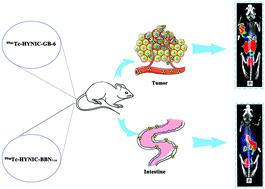当前位置:
X-MOL 学术
›
Biomater. Sci.
›
论文详情
Our official English website, www.x-mol.net, welcomes your
feedback! (Note: you will need to create a separate account there.)
GRPR-targeted SPECT imaging using a novel bombesin-based peptide for colorectal cancer detection
Biomaterials Science ( IF 5.8 ) Pub Date : 2020-10-20 , DOI: 10.1039/d0bm01432j Peifei Liu 1, 2, 3, 4, 5 , Yuanbiao Tu 1, 2, 3, 4, 5 , Ji Tao 1, 2, 3, 4, 5 , Zicun Liu 1, 2, 3, 4, 5 , Fang Wang 1, 2, 3, 4, 5 , Yi Ma 1, 2, 3, 4, 5 , Zhaolun Li 1, 2, 3, 4, 5 , Zhihao Han 1, 2, 3, 4, 5 , Yueqing Gu 1, 2, 3, 4, 5
Biomaterials Science ( IF 5.8 ) Pub Date : 2020-10-20 , DOI: 10.1039/d0bm01432j Peifei Liu 1, 2, 3, 4, 5 , Yuanbiao Tu 1, 2, 3, 4, 5 , Ji Tao 1, 2, 3, 4, 5 , Zicun Liu 1, 2, 3, 4, 5 , Fang Wang 1, 2, 3, 4, 5 , Yi Ma 1, 2, 3, 4, 5 , Zhaolun Li 1, 2, 3, 4, 5 , Zhihao Han 1, 2, 3, 4, 5 , Yueqing Gu 1, 2, 3, 4, 5
Affiliation

|
Colorectal cancer (CRC) is the third most common cancer worldwide, and the prognosis of CRC is better with an earlier diagnosis. The presence of the gastrin-releasing peptide receptor (GRPR) has been documented in very high numbers on colorectal cancer cells, which makes it an ideal biomarker for the diagnosis of CRC. Bombesin (BBN) peptide analogs have been extensively investigated for the imaging of human cancers with GRPR overexpression. Recently, we have reported a novel GRPR-targeted peptide named the GB-6 peptide. The GB-6 peptide based on BBN7–14 was designed to improve in vivo metabolic stability and decrease intestinal uptake. Meanwhile, GB-6 greatly retained the original GRPR-binding affinity of BBN7–14. In this study, the GB-6 peptide was labeled with radionuclide 99mTc or fluorescent dye for colorectal cancer imaging. In vitro receptor binding was studied in Caco-2 cells, and the GRPR targeting capacity and kinetics in vivo were evaluated using Caco-2 tumor xenografted mice models. In addition, cells and mice were also subjected to the corresponding BBN7–14 conjugations for comparison. The GB-6 peptide exhibited specific GRPR binding in vitro with a high affinity similar to that of BBN7–14. Furthermore, we observed that GB-6 showed higher tumor uptake and displayed lower intestinal activity than corresponding unmodified probe BBN7–14 in Caco-2 tumor-bearing mice. Overall, our studies demonstrated that GB-6 has the potential for early detection of CRC patients, and it may also serve as a valuable tool for non-invasive monitoring of colorectal tumor growth.
中文翻译:

GRPR靶向SPECT成像,使用新型基于蛙皮素的肽段检测大肠癌
大肠癌(CRC)是全球第三大最常见的癌症,早期诊断可以更好地治疗CRC。胃泌素释放肽受体(GRPR)的存在已在结直肠癌细胞上大量报道,这使其成为诊断CRC的理想生物标志物。Bombesin(BBN)肽类似物已被广泛研究用于GRPR过表达的人类癌症的成像。最近,我们报道了一种新型的GRPR靶向肽,名为GB-6肽。基于BBN 7-14的GB-6肽旨在改善体内代谢稳定性并减少肠道摄取。同时,GB-6大大保留了BBN 7-14的原始GRPR结合亲和力。在这项研究中,GB-6肽用放射性核素99m Tc或荧光染料标记,用于大肠癌成像。在Caco-2细胞中研究了体外受体结合,并使用Caco-2肿瘤异种移植小鼠模型评估了GRPR的靶向能力和体内动力学。此外,还对细胞和小鼠进行了相应的BBN 7-14偶联以进行比较。GB-6肽在体外表现出特异性GRPR结合,具有与BBN 7–14相似的高亲和力。此外,我们观察到与相应的未修饰探针BBN 7–14相比,GB-6表现出更高的肿瘤吸收和更低的肠道活性在Caco-2荷瘤小鼠体内。总体而言,我们的研究表明,GB-6具有早期发现CRC患者的潜力,并且还可以作为无创监测结直肠肿瘤生长的有价值的工具。
更新日期:2020-11-03
中文翻译:

GRPR靶向SPECT成像,使用新型基于蛙皮素的肽段检测大肠癌
大肠癌(CRC)是全球第三大最常见的癌症,早期诊断可以更好地治疗CRC。胃泌素释放肽受体(GRPR)的存在已在结直肠癌细胞上大量报道,这使其成为诊断CRC的理想生物标志物。Bombesin(BBN)肽类似物已被广泛研究用于GRPR过表达的人类癌症的成像。最近,我们报道了一种新型的GRPR靶向肽,名为GB-6肽。基于BBN 7-14的GB-6肽旨在改善体内代谢稳定性并减少肠道摄取。同时,GB-6大大保留了BBN 7-14的原始GRPR结合亲和力。在这项研究中,GB-6肽用放射性核素99m Tc或荧光染料标记,用于大肠癌成像。在Caco-2细胞中研究了体外受体结合,并使用Caco-2肿瘤异种移植小鼠模型评估了GRPR的靶向能力和体内动力学。此外,还对细胞和小鼠进行了相应的BBN 7-14偶联以进行比较。GB-6肽在体外表现出特异性GRPR结合,具有与BBN 7–14相似的高亲和力。此外,我们观察到与相应的未修饰探针BBN 7–14相比,GB-6表现出更高的肿瘤吸收和更低的肠道活性在Caco-2荷瘤小鼠体内。总体而言,我们的研究表明,GB-6具有早期发现CRC患者的潜力,并且还可以作为无创监测结直肠肿瘤生长的有价值的工具。











































 京公网安备 11010802027423号
京公网安备 11010802027423号